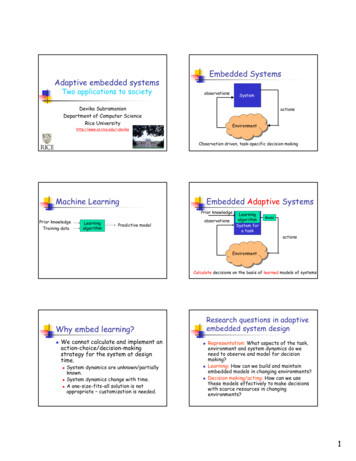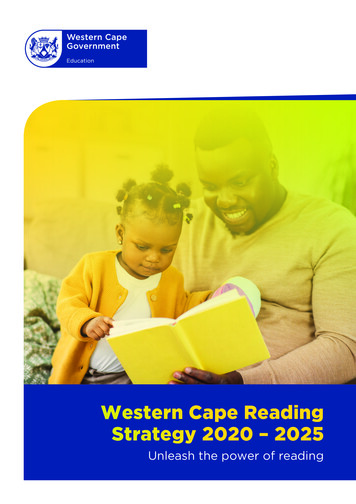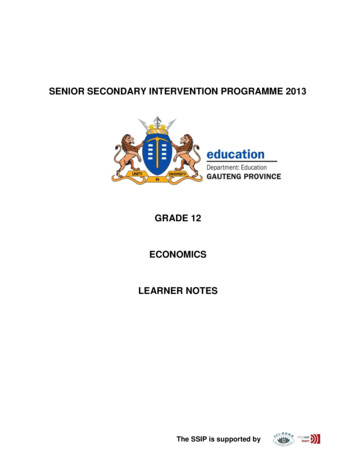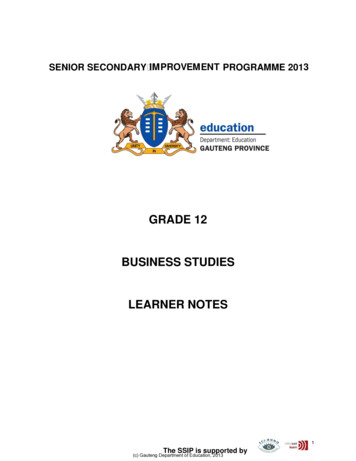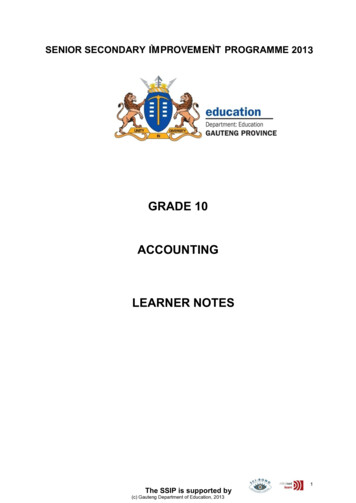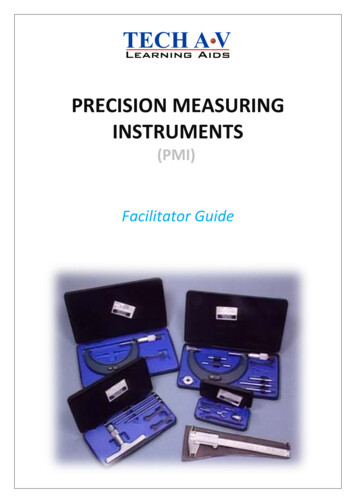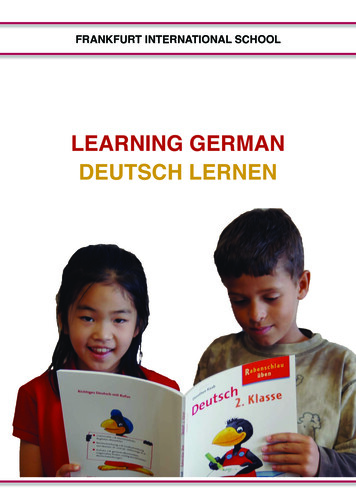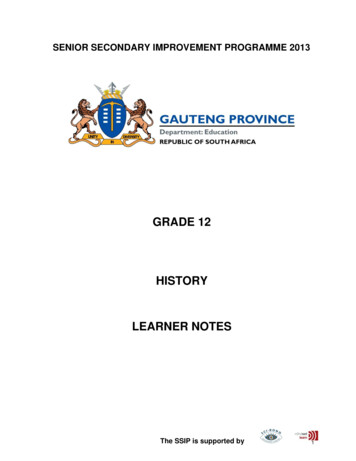
Transcription
SENIOR SECONDARY IMPROVEMENT PROGRAMME 2013GRADE 12HISTORYLEARNER NOTESThe SSIP is supported by1
TABLE OF CONTENTSLEARNER NOTESSESSIONTOPICPAGE6South Africa Emerging as a Democracy – 1994 Onwards3 - 167Cold War – Areas & Forms of Conflict: Angola17 - 32The SSIP is supported by12
GAUTENG DEPARTMENT OF EDUCATIONHISTORYSENIOR SECONDARY IMPROVEMENT PROGRAMMESESSION 6GRADE 12(LEARNER NOTES)SESSION 6TOPIC: SOUTH AFRICA EMERGING AS A DEMOCRACY – 1994 ONWARDSSECTION A: TYPICAL EXAM QUESTIONSKEY QUESTION:DID THE TRUTH AND RECONCILIATION COMMISSION (TRC) SUCCEED INUNCOVERING THE TRUTH OF SOUTH AFRICA'S PAINFUL PAST?Learner Note: The Key Question will appear at the beginning of every section in theexam paper. This question tells you what the OVERALL content to be tested will be. Inthis case, the Key Question tells us the section will test if the TRC succeeded in revealingthe truth in South Africa’s past. NB: You DO NOT answer this question!Remember to answer all questions in FULL SENTENCES, as bullet points are notacceptable in an exam situation. Also, you must be specific as to which source and whichpart of the source you are speaking of.QUESTION 1:1.1.11.21.31.41.51.61.71.81.933 minutes(Taken from DOE Feb-Mar Examination 2010 Paper 2)Use Source A.Why did Phila leave South Africa illegally?What was Umkhonto weSizwe and why was it created?Quote evidence from the source to show that Phila was a successin MK.Account for the sudden disappearance of Phila in October 1988.(Viewpoint 1)Explain how the police decided to 'neutralise her'.Who were the Askaris?Why did the police decide to kill Phila?Explain whether the police were justified in applying for amnesty.By examining both viewpoints, what conclusions can a historiandraw about MK operatives and police responses to MK?(1 x 2) (2)(2 x 2) (4)(2 x 1) (2)(1 x 2)(2)(2 x 2)(1 x 2)(2 x 2)(2 x 2)(4)(2)(4)(4)(3 x 2)(6)[30]Learner Note: “Account for” (Question 1.4) is just another way of saying “Give reasonsfor”.When asked to quote evidence from the source, you must put the selected phrase orsentence in quotation marks.3
GAUTENG DEPARTMENT OF EDUCATIONHISTORYGRADE 12SENIOR SECONDARY IMPROVEMENT PROGRAMMESESSION 6(LEARNER NOTES)SOURCE AThe following extract is taken from Truth Justice Memory and comprises two viewpoints.VIEWPOINT 1: Experiences of MK recruits and experiences told at the TRChearing.Phila Portia Ndwandwe left South Africa illegally to join Umkhonto weSizwe after she leftschool and did her basic military training in Angola in 1985. The name given to her by MKwas Zandi or Zandile. Her commanders at the time remember her as exemplary, highlyintelligent, committed and hard-working. After her training, she was sent to Swaziland,from where MK's operations in KwaZulu-Natal were run. Her dedication impressed herseniors so much that she was promoted to MK commander for the Natal operations.Richard Jones, a member of Phila's unit, remembers her as a 'strong person, with apowerful personality, and she had a strong and powerful body too'. Her unit was verysuccessful and Phila was growing in stature in MK. Phila and her MK comrade BhekiMabuza started living together in Manning and had a baby in June 1988. They called himThabang.VIEWPOINT 2: Testimony given by the police in an application for amnesty at theTRC hearing.The police were worried about the effectiveness of Phila's unit, and decided to neutraliseher. They decided to abduct her from Swaziland and then to persuade her to switch sidesand work against MK. In October 1988, the men went into Swaziland using falsepassports, accompanied by two Askaris, former MK operatives who had switched sides.The Askaris set up a meeting with Phila in Manzini. Her colleague Richard Jones droveher to the meeting. She told him she would see him later, and then got into the bakkiewith the Askaris. According to the policemen, Phila's hands were then tied and driven tothe border, where she was forced to creep through the border fence with them. Back inSouth Africa, Phila's interrogation started. Major Hendrik Botha testified that he hadasked her to cooperate with them as a police informer, but she refused and nevershowed any sign that she would consider it. Botha and Wasserman denied allsuggestions by the TRC that they had tortured Phila, although she was forced toundress. They admitted that they never had any intention of prosecuting her.Phila was also interrogated by security policemen of the then Eastern Transvaal branch,and then by Colonel Johannes Steyn. Phila told him she would never cooperate with him,no matter what they did to her, and would continue with her MK activities should she bereleased. The policemen concluded that Phila was 'too tough a nut to crack', that shewas very brave and would never betray her comrades. Steyn then ordered Phila to bekilled.4
GAUTENG DEPARTMENT OF EDUCATIONHISTORYQUESTION 2:GRADE 12SENIOR SECONDARY IMPROVEMENT PROGRAMMESESSION 6(LEARNER NOTES)17 minutesSOURCE BThe following is an extract from the submission to the TRC delivered by the IFP leader,Mangosuthu Buthelezi.My own deep conviction is that violence is evil and must not be used for politicalpurposes. And despite the IFP's constant vigil to keep violence out of the IFP's politics, Iknow that members and supporters have been drawn into violence. I say I'm sorry to SAfor this, for although I've not orchestrated one single act of violence against one singlevictim of this violence that has cost us many lives, as the leader of the IFP [InkathaFreedom Party] I know that the buck stops right in front of me. From my side I wish to sayI'm sorry for any hurt that I've caused the ANC leadership. I sincerely hope that theapology to Mr Mandela and others that I carry in my heart will be as simply and publiclymade by him and others as I have now myself again done. I know, because we arehuman beings and, therefore, sinners, that we shall still hurt each other tomorrow. Inevertheless apologise for the past hurts and I do so on behalf of my followers.2.2.12.22.32.42.52.6Refer to Source B.Using your own knowledge, explain what violence the IFP wereinvolved in with the ANC?Why do you think Buthelezi felt it necessary to apologise to theANC?What role would Buthelezi have in the new democracy?How would you describe the tone of this submission?In what way does this apology contribute towards reconciliationand nation-building?Explain how this source reflects the aims of the TRC?QUESTION 3:(2 x 2)(4)(2 x 2)(4)(2 x 1)(1 x 1)(2 x 1)(2)(1)(2)(2 x 1)(2)[15]36 minutesEXTENDED WRITING (The length of your response should be about TWO pages.)The TRC's attempt to uncover the truth and bring reconciliation was a success.Do you agree? Discuss.[30]Learner Note: This essay requires you to DISCUSS the TRC’s attempt to uncover thetruth. This means that you must write about the successes, the failures and thelimitations of the TRC, and then you must decide if you agree with the statement or not.The essay question counts 40% of the exam. You need to learn the format and how torefer to sources. No bullet points allowed!5
GAUTENG DEPARTMENT OF EDUCATIONHISTORYGRADE 12SENIOR SECONDARY IMPROVEMENT PROGRAMMESESSION 6(LEARNER NOTES)SECTION B: ADDITIONAL CONTENT NOTESSOUTH AFRICA EMERGING AS A DEMOCRACY – 1994 ONWARDSAfter the elections of 1994, South Africa was led by the Government of National Unity.This was a coalition government, led by the ANC, headed by Nelson Mandela, includingmembers of the NP and IFP. The Government of National Unity was to oversee a newSouth African constitution.The new South African Constitution was adopted on 8 May 1996. The Constitution isconsidered by many as one of the most advanced in the world, with a Bill of Rights secondto none. South Africa's Constitution was drafted by an all-inclusive constitutive assembly,which had representatives from all the major political parties and liberation organisations.The constitutional assembly sat between May 1994 and October 1996 drafting andcompleting the new constitution. The new Constitution was the embodiment of the visionof generations of anti-apartheid freedom fighters and democrats. These people had hadfought for a South Africa that belonged to all, and for non-racialism and human rights.The guiding principles of the new constitution were first articulated in the ANC's AfricanClaims document of 1943, the Non-European Unity Movements 10 point program of 1943,and the 1955 Congress Alliance Freedom Charter. The Constitution is the supreme law ofthe land, against which all other laws are judged.The constitution made provision for the establishment of a constitutional court which is thefinal arbitrator of the inter-operation of the constitution. The constitution makes provisionsfor the way the country is governed, the establishment of parliament, the election of thepresident, the creation and government of provinces and local authorities.6
GAUTENG DEPARTMENT OF EDUCATIONHISTORYSENIOR SECONDARY IMPROVEMENT PROGRAMMEGRADE 12SESSION 6(LEARNER NOTES)Do you know the Pre-amble to the constitution?We, the people of South Africa, Recognise the injustices of our past;Honour those who suffered for justice and freedom in our land;Respect those who have worked to build and develop our country; andBelieve that South Africa belongs to all who live in it, united in our diversity.We therefore, through our freely elected representatives, adopt this Constitution as thesupreme law of the Republic so as to- Heal the divisions of the past and establish asociety based on democratic values, social justice and fundamental human rights;Lay the foundations for a democratic and open society in which government is based onthe will of the people and every citizen is equally protected by law;Improve the quality of life of all citizens and free the potential of each person; andBuild a united and democratic South Africa able to take its rightful place as a sovereignstate in the family of nations.May God protect our people.Nkosi Sikelel' iAfrika. Morena boloka setjhaba sa heso.God seën Suid-Afrika.God bless South Africa.Mudzimu fhatutshedza Afurika.Hosi katekisa Afrika.Pre-amble means 'attached to the beginning'.Post-amble means 'attached to the end'.In an interview, Nelson Mandela said:"With the exception of the atrocities against the Jews during the Second World War, thereis no evil that has been as condemned by the entire world as Apartheid."- Source: Sunday Independent, December 6, 1998.The apartheid government in South Africa came to an end in 1994, but the newgovernment in South Africa had to work through the question of dealing with the past inorder to move forward. The critical question was: Should crimes against the victims ofapartheid be punished?7
GAUTENG DEPARTMENT OF EDUCATIONHISTORYGRADE 12SENIOR SECONDARY IMPROVEMENT PROGRAMMESESSION 6 (LEARNER NOTES)At the end of the Second World War, the Allies who defeated Nazi Germany chose topunish the perpetrators of genocide. Perpetrators were put on trial in the city ofNuremburg and punished. South Africa chose not to go the route of the Nuremberg trials.The new democratic government in South Africa after apartheid chose instead to focus onthe victims. Therefore, it was decided that the way to heal the apartheid past was to hold aTruth and Reconciliation Commission.The TRC planned to give a voice to the victims of apartheid who had suffered grosshuman rights violations. They were encouraged to come forward and tell their stories. Theterms of a commission were spelled out in a post-amble to the Constitution:". there is a need for understanding but not for vengeance; need for reparation but not forretaliation; a need for ubuntu but not for victimisation.” Archbishop Desmond Tutu was the Chairperson of the TRC. He explained:"Forgiveness will follow confession and healing will happen, and so contribute to nationalunity and reconciliation.” Amnesty: a warrant granting release from punishment for an offenceThe Truth and Reconciliation Commission was not a court as such, but a different kind offorum set up to deal with political crimes committed during apartheid. The AmnestyCommittee had the power to grant amnesty for politically motivated crimes that were fullyand truthfully confessed, under certain conditions. Amnesty is the act of government bywhich pardon is granted to a large group of individuals.The TRC's approach is widely considered to be one of restorative justice, as opposed toretributive justice.The Human Rights Violation Committee decided on acts that constituted violations ofhuman rights based on statements made to the TRC. Once victims of gross human rightsviolations were identified, they were referred to the Reparation and RehabilitationCommittee, which decided on how to compensate victims. Those who were not grantedamnesty by the TRC for crimes committed during apartheid, could be prosecuted.The emphasis of the TRC was on truth telling, forgiveness and reconciliation. The TRCwas based on the belief that if the truth were known about the South African past, healingwould take place. Perpetrators who committed gross human violations were promisedamnesty if they came forward and made a full disclosure of the crimes they hadcommitted. This meant they would not be punished for their crimes if they told the wholetruth.Victims told horrifying but often-poignant stories, and perpetrators admitted to committinghorrendous crimes. There were moving scenes of reconciliation, but at many times angerand hostility erupted. Friends and families of victims and perpetrators alike came to listento evidence and offer support.For many victims of apartheid crimes, this process promoted reconciliation and healing; forothers it did not.8
GAUTENG DEPARTMENT OF EDUCATIONHISTORYGRADE 12SENIOR SECONDARY IMPROVEMENT PROGRAMMESESSION 6(LEARNER NOTES)New identities: Human Rights for allThe Universal Declaration of Human Rights (UDHR) was adopted by the United NationsOrganisation (UNO) in 1948. It is the basis for human rights protection and promotionaround the world.In the same year that the UDHR was accepted at the UNO in 1948, the National Partycame to power in South Africa. They put into practice the racist policy of apartheid, underwhich black South Africans were denied basic human rights. The system of apartheidclearly did not meet the standards set by the UDHR. The apartheid government did notsign the UDHR, and apartheid was later declared a Crime against Humanity by the UNO.In South Africa under apartheid, people who lived within South Africa's borders weretaught that they were different because they had different skin colours. Laws were appliedwhich benefited whites, and oppressed blacks. There was no common sense of nationalunity.After the 1994 democratic election in South Africa, a new non-racial constitution wasdrawn up. It includes a Bill of Rights, and is based on the UDHR.A challenge for the democratic government is to create a new national identity from adivided legacy of division and discrimination.However, we continue to be divided by our blackness and our whiteness. The Chairman ofthe SA Human Rights Commission (SAHRC), Jody Kollapen said as recently as March,2008:"I think the challenge is to transcend the sense that we have over our blackness and ourwhiteness.I think it requires hard work and I think it requires ordinary people to speak toeach other."The construction of heritage: new symbols of unityThese are some of the things that were used to construct a new South African identity,and a new heritage for a democratic nation of South Africans:National Symbols were changedNational Anthem: South Africa adopted a new National Anthem in the spirit ofreconciliation, a combination of "Nkosi Sikelel'” and "Die Stem”Flag: The new national flag of the Republic of South Africa was first used on 27 April1994.Coat of Arms: A new National Coat of Arms was adopted. The motto is:!ke e: /xarra //ke,written in the Khoisan language of the /Xam people, literally meaning: diverse peopleunite. It calls for the nation to unite in a common sense of belonging and national pride Unity in Diversity.National sports teams were createdUnder apartheid, national sports teams were made up of whites only. South Africa wasboycotted from participating in international sport during the apartheid years. South Africanteams now compete against people from all over the world.9
GAUTENG DEPARTMENT OF EDUCATIONHISTORYGRADE 12SENIOR SECONDARY IMPROVEMENT PROGRAMMESESSION 6(LEARNER NOTES)However, racism in sport is still prevalent in South Africa despite the country declaring allforms of racism illegal. Merit selection of teams is often dubiously used to excludedisadvantaged individuals from being selected into elite teams.South African joined international organisationsDuring apartheid, South Africa was excluded from international bodies. Since 1994, SouthAfrica has been welcomed into the international community, and belongs to, for example,Southern African Development Community (SADC), the African Union, theCommonwealth and the United Nations Organisation.South Africa officially assumed its seat as a non-permanent member of the United NationsSecurity Council in January 2007, the first time the country has sat on the UN's mostpowerful organ.New heritage sites were createdSince 1994, many new heritage sites and museums have been opened to contribute toforging a new South African identity. These include:The Apartheid Museum in Johannesburg: This pre-eminent museum deals with 20thcentury South Africa, at the heart of which is the apartheid story.Freedom Park in Tshwane: This memorial aims to mobilise for reconciliation and nationbuilding in our country; to reflect upon our past, to improve our present and build our futureas a united nation; to contribute continentally and internationally to the formation of betterhuman understanding among nations and peoples.Robben Island Museum (RIM) near Cape Town: This museum aims to develop the islandas a national and international heritage and conservation site. RIM strives to maintain theunique symbolism of the island, nurture creativity and innovation. This museum also aimsto contribute to socio-economic development, the transformation of South African societyand the enrichment of humanity.Museums Online South Africa: This online heritage portal gives access to most SouthAfrican museums.New provinces were createdSouth Africa under Apartheid had four provinces - Cape Province, Orange Free State,Transvaal, and Natal. The new South Africa has nine provinces - Western Cape, EasternCape, Northern Cape, the Free State, KwaZulu-Natal, Gauteng, Mpumalanga, NorthwestProvince, and Limpopo Province (initially Northern Province).Some towns and streets were renamedThe renaming process is part of a national drive to make South African cities and streetnames sound more inclusive and less reflective of the colonial and apartheid past. Forexample, the cities of Pietersburg, Louis Trichardt, and Potgietersrust were named afterAfrikaner leaders. They became, Polokwane, Makhoda, and Mokopane.Within South Africa, the process remains controversial, and renaming is likely to continuefor a long time as South Africa continues to redefine itself.10
GAUTENG DEPARTMENT OF EDUCATIONHISTORYGRADE 12SENIOR SECONDARY IMPROVEMENT PROGRAMMESESSION 6(LEARNER NOTES)Airport names were changedThe names of all South African airports were first changed from Apartheid politician'snames to the city or town where they are located. Later, Johannesburg InternationalAirport was changed to OR Tambo International Airport after the great ANC leader.Taken from: dentity-and-heritagegrade-12SECTION C: HOMEWORKLearner Note: If you have difficulty with the homework questions, you should refer to thecontent notes or to your class teacher for assistance.QUESTION 1:(Taken from DOE Feb-Mar Examination 2010 Paper 2)SOURCE CThe following cartoon by Zapiro appeared in the Sowetan of 25 July 1999.11
GAUTENG DEPARTMENT OF EDUCATIONHISTORY1.11.21.31.41.5GRADE 12SENIOR SECONDARY IMPROVEMENT PROGRAMMESESSION 6(LEARNER NOTES)Why, in the opinion of the cartoonist, is the carpet markedNP appropriate?What do the figures in the cartoon symbolise?What is implied by: 'The trick is to shout so loudly that westart to look like victims'?Explain how this cartoon adds value to the work of the TRCand explain how some could argue that it devalues the TRC.Explain the reference to:(a) Detainees murdered(b) Hit squads(3 x 1)(3)(2 x 1)(2 x 2)(2)(4)(4 x 1)(4)(2 x 1)(2)[15]SECTION D: SOLUTIONS FOR SECTION ALearner Note: Mark allocation works as follows:(Number of correct facts x Number of marks) (TOTAL MARKS)QUESTION 11.11.21.31.41.5[Extraction from Source A – L1 – LO1 (AS3); LO3 (AS2)] To join Umkhonto weSizwe[Interpretation and evaluation of evidence from Source A – L3 –LO1 (AS3); LO3 (AS2)] The armed military wing of the ANC created by the youth leagueleaders. Created in response to Sharpeville and increased policerepression.(1 x 2)(2)[Extraction of evidence from Source A – L1 – LO1 (AS3)] Exemplary, highly intelligent, committed and hard working Promoted to MK commander for Natal operations[Extraction of evidence from Source A – L1 – LO1 (AS3)] Phila was abducted by her former comrades from Swaziland Any other relevant response[Interpretation and evaluation of evidence from Source A – L3- LO1(AS3); LO2 (AS2)]If they could not get her to change sides and turn on her comradesthey would kill her as she was too big a risk.(2 x 1)(2)(1 x 2)(2)(2 x 2)(4)(2 x 2) (4)12
GAUTENG DEPARTMENT OF EDUCATIONHISTORY1.6SESSION 6(LEARNER NOTES)[Analysis and interpretation of evidence from Source A - L3- LO1(AS3); LO3 (AS3)] Former MK soldiers who became police informers Any other relevant response[Interpretation and analysis of evidence using Source A - L3- LO3(AS2,3)] She refused to cooperate with the police and betray the struggle Try to send a message to other MK operativesAny other relevant response.[Interpretation of evidence from Source 4A – L3 – LO1 (AS3);LO2 (AS2); LO3 (AS2)]JUSTIFIED TRC was a mechanism established by law for people to comeforward with information The police were exercising their right to amnesty They were safeguarding themselves against prosecution shouldsomeone decide to talk1.71.81.9GRADE 12SENIOR SECONDARY IMPROVEMENT PROGRAMME NOT JUSTIFIED Their act was not politically motivated They acted outside of the law They testified that they were not prepared to prosecute herMK OPERATIVESHighly ntCowardlyMerciless(1 x 2)(2)(2 x 2)(2)(2 x 2)(4)(3x2)(6)[30]QUESTION 22.12.2[Interpretation and explanation of evidence from Source B – L3 – LO1 (2 x 2)(AS3); LO3 (AS2)] In the dying years of Apartheid violence escalated betweenthe IFP and ANC as each jockeyed for power. Manybelieved the IFP were aided by the NP in order todestabilise ANC. Boipatong massacre.[Interpretation and explanation of evidence from Source B – L3 – LO1 (2 x 2)(AS3); LO3 (AS2)] Many people were killed in the political violence(4)(4)13
GAUTENG DEPARTMENT OF EDUCATIONHISTORYSENIOR SECONDARY IMPROVEMENT PROGRAMMEGRADE 12SESSION 6(LEARNER NOTES) He was morally responsible as some people were killing in hisorganisation and others killed for belonging to his organisation As Christian he understood forgiveness was important Knows that it will protect his party in a dominated ANCgovernment He believes in reconciliation Any well-argued opinion.2.32.42.5Deputy President in the GNU(1 x 1)[Interpretation of evidence from Source B – L3 – LO1 (AS3); LO2(2 x1)(AS2); LO3 (AS2)] Reconciliatory Sincere Remorse Any other relevant response[Interpretation and evaluation of evidence from Source B – L2 – LO1 (2 x 1)(AS3); LO2 (AS2); LO3 (AS2)] One of the leading ANC opposition parties has a leader willing toapologise and face the truth. This sets an example for allleaders in society and society as a whole to seek forgiveness sothat we can move on. The apology suggests acceptance by theIFP and a willingness to work together to move on.(1)(2)(2)Any well-argued and relevant response.2.6This admission of guilt, apology and taking responsibility for the(2 x 1) (2)increased violence is what Tutu wanted from the TRC. He wantedplayers to come forward with their own story and to tell the truth.In that way people can move forward through forgiveness and honesty.[15]QUESTION 3EXTENDED WRITING[Plan and construct an argument based on evidence using analytical and interpretativeskills - L1 – LO1 (AS3&4); LO2 (AS1, 2 &3); LO3 (AS1, 2, 3 &4)]Candidates should include the following aspects in their response:SYNOPSISCandidates should discuss whether they agree or disagree that the TRC was a success.MAIN ASPECTSIntroduction: Candidates should introduce their essay with a relevant introduction andstate whether they agree or disagree.14
GAUTENG DEPARTMENT OF EDUCATIONHISTORYGRADE 12SENIOR SECONDARY IMPROVEMENT PROGRAMMESESSION 6(LEARNER NOTES)ELABORATIONAGREE In some cases there was genuine commitment to reconciliation In some cases victims were prepared to forgive People came forward to narrate about what they knew Perpetrators came forward with evidence which could have been difficult in a court oflaw Other victims decided to challenge the TRC TRC managed to uncover what could not be uncovered in a normal court of law Reconciliation was achieved Catastrophe was avoided Country was given a new lease of lifeDISAGREE Many high ranking government officials did not come forward to testify Many atrocities left uncovered Many victims felt short changed by TRC hearings and instituted criminal charges P.W.Botha indifferent to the desire for peace, reconciliation and nation building Many people still not accounted for Any other relevant responseCONCLUSIONCandidates should tie up their argument with a relevant conclusion.Use the matrix on the next page to assess this extended writing question.[30]15
GAUTENG DEPARTMENT OF EDUCATIONHISTORYGRADE 12SENIOR SECONDARY IMPROVEMENT PROGRAMMESESSION 6(LEARNER NOTES)The SSIP is supported by16
GAUTENG DEPARTMENT OF EDUCATIONHISTORYGRADE 12SENIOR SECONDARY INTERVENTION PROGRAMMESESSION 7(LEARNER NOTES)SESSION 7TOPIC: COLD WAR – AREAS & FORMS OF CONFLICT: ANGOLASECTION A: TYPICAL EXAM QUESTIONSKEY QUESTION:HOW DID THE COLD WAR AFFECT INDEPENDENCE IN ANGOLA?Learner Note:The Key Question will appear at the beginning of every section in the exam paper. Thisquestion tells you what the OVERALL content to be tested will be. In this case, the KeyQuestion tells us the section will test how The Cold War affected Angola. NB: You DONOT answer this question!Learner Note: How to analyse a cartoonCartoons will give the artist‟s point of view on a particular topic. They are useful inreflecting the attitudes of the time. When studying a cartoon ask the followingquestions:1. How are the people drawn? Are they realistic? What size are they? Are some oftheir features exaggerated? How are they dressed?2. What view of the people does the cartoon give?3. What else is included in the cartoon? Is there any writing on the cartoon itself?4. What symbols are used to get the message across?5. What information do the date and caption contribute?6. Where was the cartoon published?7. What is the artist‟s intention?8. Does the cartoon offer a positive or negative perspective on the topic?9. What do you know of the period that might support your view of the cartoon?10. What does the interpretation of the topic tell you about the artist? Can you findbias? Can you work out what issue or whom the cartoonist supports?- Taken from Oxford In Search of History, p 52
GAUTENG DEPARTMENT OF EDUCATIONHISTORYGRADE 12QUESTION 1:SENIOR SECONDARY INTERVENTION PROGRAMMESESSION 7(LEARNER NOTES)15 minutesStudy the sources and use your own knowledge to answer the following questions.Learner Note: In respect of the Cold War, the focus for the exams is on Angola. Angolabecomes the pawn in the balance of power between the Soviet Union and the UnitedStates. One must note that in Angola civil conflict is manipulated by the Cold Warpowers to increase their prestige.SOURCE AAngola is potentially one of the richest countries in sub-Saharan Africawith extensive petroleum reserves, rich agricultural land and valuablemineral resources. Few countries in the world have experienced aswell as sustained the degree of violent conflict seen in Angola.Intervention has diminished but has not disappeared. Angola‟sabundant natural resources continue to attract outside interests fromindustrialised nations globally. In the competition for oil, diamonds andother precious resources in Angola, interests external to Angolacontinue to play a large and decisive role, both in suppressing conflictand in sustaining it.The end of the Cold War changed the political landscape of Africasince the 1990‟s and opened new vistas for the continent, it helped inreshaping international relations as well as the emergence of newconcepts of security and self interest. It eliminated the division ofAfrica into two ideological camps and eliminated a source of externalsupport that was taken for granted.Cold War diplomacy in Angola: The emergence of New Foci of Powerby Dr. Skyne Uku-Wertimer.Learner Note: Remember to answer all questions in FULL SENTENCES, as bulletpoints are not acceptable in an exam situation. Also, you must be specific as to whichsource and which part of the source you are speaking about in your answer. Whenasked to quote make sure your answer has quotation marks and that the quotationincludes only the relevant phrase or sentence.
GAUTENG DEPARTMENT OF EDUCATIONHISTORY1.1GRADE 12SENIOR SECONDARY INTERVENTION PROGRAMMESESSION 7(LEARNER NOTES)The source refers to violent conflict in Angola. This violent conflict began withAngola‟s independence in 1975. Briefly explain why independence sparked
GAUTENG DEPARTMENT OF EDUCATION SENIOR SECONDARY IMPROVEMENT PROGRAMME HISTORY GRADE 12 SESSION . 6 (LEARNER NOTES) SOUTH AFRICA EMERGING AS A DEMOCRACY - 1994 ONWARDS. After the elections of 1994, South Africa was led by the Government of National Unity. This was a coalition government, led by the ANC, he. aded by Nelson Mandela, including


